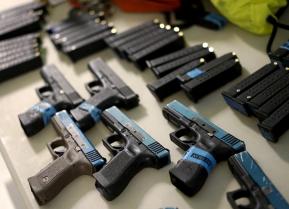Meet the G3 Battle Rifle (And It's a Legend for a Reason)
A Cold War classic?
In the late 1950s, the Bundeswehr, West Germany’s armed forces, needed a new infantry rifle. Part practical endeavor and part rebranding effort, the adoption of the G3 battle rifle was a symbolic establishment of the West German Army as an independent military force. The sturdy, beefy 7.62-millimeter rifle would serve nearly forty years, first on the Iron Curtain’s frontier and later as the first rifle of a reunified Germany.
The armed forces of West Germany were founded in 1955, ten years after the defeat of Nazi Germany. The breakdown of the wartime alliance between the United States, United Kingdom, France and Soviet Union divided Germany into two states, West Germany and East Germany, separated along ideological lines. The large number of Soviet conventional forces in Eastern Europe, particularly East Germany, could not be effectively countered without some form of West German remilitarization, and once established the Bundeswehr quickly evolved to become the backbone of NATO’s defense plan.
The West German army was originally supplied with surplus American small arms, including the M-1 Garand rifle. The Soviet deployment of the AK-47 assault rifle was an alarming development, sounding warning bells across a NATO that had largely neglected small arms after World War II. The AK-47 was chambered in 7.62x39-millimeter, capable of fully automatic fire and fed from a thirty-round box magazine, A Red Army unit equipped with the AK-47 could generate far more firepower than one equipped with the M-1 Garand. In the event of war, Bonn’s army—and most NATO infantry, for that matter—would be outgunned at the small unit level.
West German officials cast their eye to Spain, where the Spanish CETME rifle held great promise. Ironically, CETME had been developed by German engineers working in France and Spain after the war, engineers that had developed the wartime Sturmgewehr-45 (StG-45) assault rifle. The CETME resembled and used many of the features of the StG-45, including a delayed blowback operating system designed to reduce recoil. The Spanish weapon was chambered in 7.62-millimeter, at the time fast becoming the standard NATO rifle caliber, and utilized a twenty-round detachable magazine.
West Germany adopted the CETME as the G3 1959. The G3 was cheap to manufacture, being largely made from stamped sheet metal and plastic, but was inexpensive and durable. Although longer than the AK-47 and using a smaller ammunition magazine, the G3’s 7.62-millimeter ammunition was theoretically more powerful and had a greater range. The G3 could fire rifle grenades from the muzzle without modification, boosting an infantry unit’s firepower. The G3 was fielded with panzergrenadier (mechanized infantry), mountain and reservist units.
The success of the G3 spurred several sub-varieties and variants. The G3A3 was the original version with a folding stock, while the G3A4 incorporated a folding stock and was issued to airborne units. Manufacturer Heckler and Koch built a version based on the 5.56-millimeter cartridge favored by the U.S. Army, the G33, followed by a similar version, the G-41, which featured a three round burst capability and accepted standard NATO 5.56-millimeter magazines. One of the more famous derivatives of the G3 was the MP-5, a nine-millimeter submachine gun that became popular with West German border guards, counter-terrorist units and U.S. Navy SEALS. The MP-5 was basically the G3 downsized for a pistol caliber round. On the other end of the variant spectrum was the PSG-1, a semi-automatic sniper rifle chambered in 7.62 with a 25.5-inch barrel.
The G3 was a success abroad, second only to its cousin the FN FAL battle rifle. In Europe, the G3 was adopted by Greece, Sweden, the Netherlands, Norway, Portugal and Turkey. The rifle enjoyed considerable success in the Middle East, with users including Saudi Arabia, Pakistan, North Yemen and the United Arab Emirates. The G3 was license-produced in Iran before the fall of the Shah and remained in Iranian Army circulation long after. The G3 was particularly popular in Africa, with two dozen countries including Angola, Ethiopia and Zaire all adopting the West German rifle.
The G3 served through the fall of the Berlin Wall, the dissolution of the Warsaw Pact and Soviet Union, and the reunification of Germany. Although superseded by the 5.56-caliber G36 assault rifle in the late 1990s, some G3s remained in service with the Bundeswehr well into the 2000s. G3A3s, equipped with high power optics, were deployed to Afghanistan as designated marksman rifles. Despite their age, the 7.62-millimeter rifles had the range to engage targets beyond the newer G36 rifle.
The G3 rifle was perhaps the ideal weapon for the newly established West German armed forces. Like previous German rifles, it was a no-nonsense weapon with an enviable reputation for accuracy and reliability. The G3 itself grew into the symbol of an armed force distancing itself from its national past, standing guard at the edge of democracy.
Kyle Mizokami is a defense and national-security writer based in San Francisco who has appeared in the Diplomat, Foreign Policy, War is Boring and the Daily Beast. In 2009 he co-founded the defense and security blog Japan Security Watch. You can follow him on Twitter: @KyleMizokami.
Image: Wikimedia Commons.


